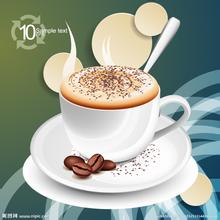US media reveals cat feces coffee industry chain: civet cats are generally enslaved and abused
Kopi Luwak has traditionally been made from coconut cat droppings collected in the wild, the report said. But its high prices have led to wild civets being captured and kept in captivity on coffee plantations. A recent report published in the journal Animal Protection assessed the survival of 48 civets on 16 plantations. The Kopi Luwak industry is "a slave industry", the report said.
Neil de Cruz, a wildlife researcher and co-author of the report at the nonprofit World Society for the Conservation of Animals, said: "Unfortunately, many tourists turn a blind eye to the cruelty of captive civets making Kopi Luwak." they even lined up to take pictures of civets and share them on social networks. "
Wild civets eat coffee beans as part of a balanced diet, while captive civets are overfed with immature coffee beans. Wild civets usually like to be nocturnal, while captive civets are kept in sunlight spaces that can easily lead to claustrophobia. When they are enraged, they fight. Many captive civets get sick or die from stress.
The US quartz financial website published a report entitled "the world's most expensive coffee is a nightmare for the animals that produce this coffee" on July 24, saying that even in the world of boutique coffee and nitrogen-cooled coffee, Kopi Luwak (also known as "civet coffee") is also the benchmark for luxury coffee. The coffee is made from partially digested coffee beans excreted by coconut cats (a civet endemic to Southeast Asia). It has a stronger flavor and a lighter sour taste. Although the price of Kopi Luwak has declined since 2013, it is still as high as $200 to $400 per kilogram (about 1300-2700 yuan per kilogram), and it is becoming more and more popular among tourists.

Important Notice :
前街咖啡 FrontStreet Coffee has moved to new addredd:
FrontStreet Coffee Address: 315,Donghua East Road,GuangZhou
Tel:020 38364473
- Prev

Starbucks has launched 38 meals from "cafe" to "restaurant"?
38 new food products strive for a stronger sense of existence Starbucks is known around the world for its focus on coffee and has always believed that the smell of coffee is the soul of a cafe. Ten years ago, its founder Howard Schultz even lost his temper because the smell of heated cheese masked the smell of coffee and angrily shouted to let the sandwich get out of Starbucks! But now, Starbucks has suddenly made a big move.
- Next

What do you think of the recent coffee dumping incident in Nestle Coffee?
Xiang Jianjun, a CIC consultant food industry researcher: as far as Nestl é is concerned, its performance in the Chinese market in the past two years is mediocre, and the terminal sales of the largest destroyed coffee are not smooth. Xu Fuji and Yinlu did not perform well in the follow-up of mergers and acquisitions; infant milk powder does not have an advantage under the competition of dominant brands such as Wyeth. At present, China's coffee market has changed, with the industry in different periods of time.
Related
- Why can American refills for free? The difference between Americano and American drip pot coffee
- Being chased out of the rain in front of Starbucks?! Store: Sheltering from rain under umbrellas poses a safety hazard
- The white moonlight has changed?! Lucky launches "Big Winter Pear American"
- Hand-brewed coffee three-stage method, high-sweet and universal brewing method to share! What does the high sweet water level of hand-brewed coffee mean?
- What is the difference between raw, refined and full espresso coffee? How to extract espresso and taste good?
- A complete list of coffee bean names and their meanings! What is Yejia Shefi coffee? Where is Mantelin coffee?
- What grade does Arida Manor Kaduai coffee beans belong to? What treatment is Arida ASD slow anaerobic sun exposure?
- The milk tea cup becomes smaller?! Overlord Tea Girl launches a new "Return to Yunnan" series
- Accused of selling counterfeit and high-priced coffee beans! Well-known boutique coffee brand "Oukelao" bowed and apologized!
- How to make espresso dumplings? Can I eat coffee and glutinous rice balls together?

